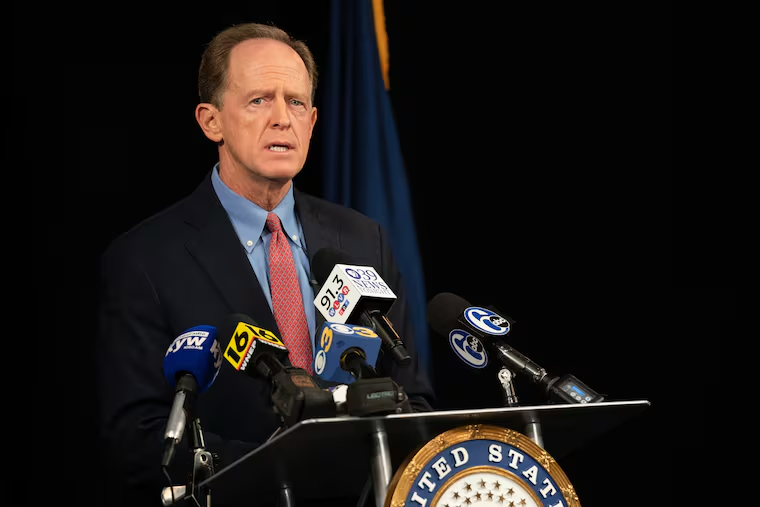Pennsylvania Sen. Pat Toomey is at the center of a last-minute dispute over Congress’ coronavirus relief bill
The argument, drawing in top congressional Democrats and Biden’s transition team, centered on Toomey’s effort to end five emergency lending programs run through the Federal Reserve.

WASHINGTON — Sen. Pat Toomey emerged as a central figure in a last-minute dispute over Congress’ $900 billion coronavirus relief package Friday, as a policy push from the Pennsylvania Republican became a major point of contention with Democrats and the incoming Biden administration, stalling a final agreement.
The argument, drawing in top congressional Democrats and President-elect Joe Biden’s transition team, centered on Toomey’s effort to end five emergency lending programs run through the Federal Reserve. His plan, supported by fellow Republicans, became one of the final sticking points on the sweeping relief package. With the parties at odds, the course of the relief plan was thrown into question.
Toomey was aiming to insert language that would halt Federal Reserve lending programs established in March, with Congress’ approval, to support businesses and some government agencies during the pandemic. His plan would also prevent the central bank from recreating them in similar fashion.
“This is all about simply ensuring that the law is followed as it was intended to be followed,” Toomey said Thursday.
Democrats accused him of trying to hamstring the economic recovery by removing a potential tool weeks before Biden takes office.
The coronavirus package “should not include unnecessary provisions that would hamper the Treasury Department and the Federal Reserve’s ability to fight economic crises,” Brian Deese, Biden’s incoming National Economic Council director, said in a statement. “As we navigate through an unprecedented economic crisis, it is in the interests of the American people to maintain the Fed’s ability to respond quickly and forcefully.”
» READ MORE: Pat Toomey is ready to work with Joe Biden. A little.
Toomey, who helped write the provisions that created the lending facilities as part of the March relief package, said they were always supposed to expire this year, were meant as emergency lending programs only, and that they are no longer necessary. Financial markets are now strong enough that businesses don’t need loans from the Fed, and the money behind the lending program, more than $400 billion, can be repurposed, Toomey argued this week.
He said preventing the program from being recreated would stop Democrats from redirecting the money to support liberal policy priorities, such as bailing out municipal governments or steering loans to green energy businesses.
“It would be a terrible idea to morph these programs into something else,” Toomey said.
Democrats argued that Toomey was trying to sabotage Biden even as millions remain out of work and there are signs the economic recovery has slowed.
Democrats called Toomey’s plan a “poison pill” that undermined a potential agreement.
“At the precipice of a deal to provide relief to American families, essential workers, and small businesses, Senate Republicans are now suddenly insisting that we limit the federal government’s ability to fight all future economic crises,” Sen. Robert Menendez (D., N.J.) said.
Toomey denied he was trying to undermine Biden, noting that he began pushing to close the lending facilities when he first worked on the bill and raised the issue again in July, well before Biden’s victory. He said his plan to limit future lending would only apply to a “narrow” range of programs.
Republicans also pointed out that many Democrats — including Menendez — derided the lending program as a “slush fund” when it was first proposed earlier this year, raising concerns that the Trump administration could use it unchecked. They accused Democrats of now changing their tune.
A Menendez aide said the Democrats’ “slush fund” criticism referred to an early proposal for the lending program, and that they supported it after more oversight and transparency was added to the final bill. Members of both parties ultimately supported the bill creating the lending program and providing $2.2 trillion in aid.